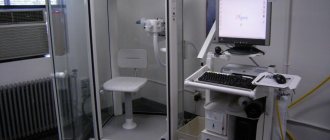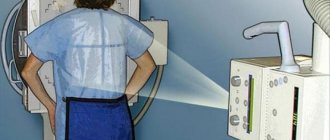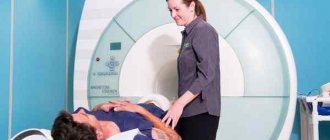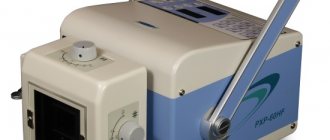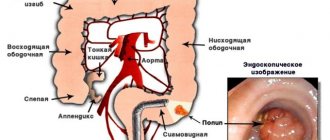One of the most accurate diagnostic methods is magnetic resonance imaging. A study is carried out to identify pathologies in the early stages, detect malignant processes and their localization, and confirm the presence of areas of the body or internal organs with massive cell damage.
As a rule, contraindications for undergoing a research procedure are minimal. Despite the fact that this type of examination is firmly entrenched in the diagnostic programs of modern treatment, and it would seem that enough is known about it, many people are still concerned about a lot of issues related to MRI.
Brief description of the method
The operation of the tomograph is to influence the magnetic field on the cells of organs and tissues that have an electromagnetic charge. The tomograph records changes occurring in the cells of the body and converts them into a three-dimensional image.
If the tomograph finds affected areas, they are separated into a separate area. The device projects the image in two sections: transverse and longitudinal.
MRI
The use of MRI helps to identify:
- boundaries and smallest formations;
- structure and type of education.
The radiation from the tomograph does not have a detrimental effect on the human body, unlike other diagnostic methods of radiography and CT. The study is allowed for children, pregnant and lactating women.
How does menstruation affect results?
The possibility of conducting research during menstruation depends on the woman’s well-being and the specific recommendations of the doctor. MRI during menstruation is performed immediately only when there are factors that threaten the patient’s life.
During menstruation, the lining of the uterus is shed, which causes pain. Because of this, difficulties may arise during the procedure, since being in the tomograph chamber requires a long period of immobility.
The presence of menstruation does not affect the results of the study. Experts refute the negative impact of electromagnetic radiation on the endocrine and reproductive systems.
When it is undesirable to carry out the procedure during menstruation
When monthly blood flow develops, enlarged regional lymph nodes are a contraindication to the procedure. In this case, MRI is not performed during menstruation (menstruation), and a resonance tomograph is not used.
Also, you should not diagnose the genital organs. Increased monthly blood flow provokes swelling of organic structures. In a swollen state of the vagina, it is very difficult to identify neoplasms, cysts and tumors. Diagnosis of the reproductive organs is carried out after the monthly blood flow has ended.
The study is not performed if there are heavy blood clots during menstruation. In the resulting image it is difficult to distinguish them from a cyst. Also, the ovaries are not examined, since the eggs are maturing. The diagnostician may confuse them with neoplasms.
A scan of the uterine endometrium will not show a reliable result. The monthly blood flow promotes the rejection of the old layer of the uterus. The new epithelium is not yet sufficiently formed.
During menstruation, scans of the uterus, vagina and ovaries are not performed. Blood discharge that accompanies monthly blood flow distorts the diagnostic picture and prevents an accurate diagnosis.
In other cases, regardless of the monthly cycle, you can safely carry out diagnostics using a tomograph. If the woman being examined does not experience discomfort during the procedure, then there is no need to abstain from the study. Timely detected pathology allows you to begin treatment that will prevent complications.
MRI of the brain and spine
An MRI of the brain involves being completely inside the capsule of the device. The lower cerebral appendage is the pituitary gland, which is responsible for regulating the monthly cycle.
The pituitary gland regulates hormonal processes occurring in the body; this does not affect the result of tomography. Changes in its work cause disruption of the menstrual cycle and hyperplastic processes of the endometrium.
When conducting an MRI of the spine, a woman’s menstrual cycle does not affect the diagnostic process, but can lead to some inconvenience:
- the woman should not make any bodily movements for some time;
- prolonged stay in the capsule causes nervous conditions, which brings discomfort.
Menstruation does not affect the results of the study and does not have a detrimental effect on the body.
MRI
Features of MRI during menstruation
When performing an MRI during menstruation, no changes occur in the woman’s reproductive system. Even if physiological bleeding has become somewhat more profuse, the reason for this is psychological stress associated with the peculiarities of the study or expectation of the result.
MRI of the brain during menstruation
When conducting a tomographic study of the brain, the effect of the magnetic field extends to the head and neck area.
One of the structures of the brain is the pituitary gland, an endocrine gland that regulates the production of almost all human hormones. This small appendage is called the main organ of the endocrine system.
The magnetic field does not adversely affect its functioning or the production of sex hormone precursors. That is, an MRI of the brain during menstruation will not entail any deviations from the norm.
On our website you can find out important information about when you should have an MRI of the brain, and you can sign up for the study in several ways:
- dial a phone number;
- order a call back;
- sign up online.
MRI of the spine during menstruation
MRI of the spine during menstruation is no different from examination during any other period of the menstrual cycle.
However, it must be remembered that the duration of tomography of the entire spine is about 1 hour. The only reason why the examination may be difficult is the patient’s well-being and the lying position while remaining still during the scan.
However, tomography is almost always easily tolerated:
- the magnetic field does not affect the course of menstruation;
- the result of the study does not depend on the phase of the menstrual cycle.
MRI of the pelvic organs during critical days
In diagnosing the pelvic organs, regardless of the research method, gynecologists are of the same opinion: with the development of acute pathology of the reproductive system, scanning should be carried out the earlier, the better, during menstruation or not - it doesn’t matter .
If the following symptoms occur, you should immediately consult a doctor:
- severe or acute pain syndrome;
- unscheduled bleeding;
- planned, but very heavy or prolonged bleeding;
- pain in the lower abdomen, heavy discharge or increased body temperature.
You should not wait until menstruation ends if there is sharp pain in the lower abdomen - it is better to seek help immediately.
At our diagnostic center you can make an appointment for an urgent MRI. To do this, just call us at 8 (812) 317-70-73 or leave an online request.
If it is necessary to diagnose a non-emergency pathology, a woman is scheduled for a tomography of the pelvic organs, often after consulting a doctor and an initial examination. This means that MRI is often performed to clarify the nature of the pathology.
Indications for such a study may be:
- prolonged aching pain in the lower abdomen;
- discomfort when emptying the bladder or defecating;
- clarification of the localization of additional education, its size;
- identification of altered lymph nodes;
- preparation for surgery on the pelvic organs;
- control after surgery, chemotherapy or radiation.
In this case, it is recommended to scan at a certain phase of the cycle. Thus, ovarian pathology is better visualized in the first phase of the cycle, that is, before day 14. The most favorable period is 6-12 days.
To identify diseases of the uterus, the optimal period for tomography is the middle of the menstrual cycle.
The call center staff will always advise you on the best time to conduct research.
MRI of the abdominal region
Tomography of the abdominal cavity helps to determine tumor processes and structural changes in organs. During menstruation, a woman's uterus increases in volume due to the accumulation of blood in the retrouterine space.
The monthly cycle affects the production of hormones and therefore adverse reactions from the gastrointestinal tract (flatulence) occur. But despite such changes in the functioning of the body, the result of the study will not be distorted and will be reliable.
Abdomen (MRI)
The effect of MRI on the female reproductive cycle
Women feel emotional discomfort if, after examination, the rejection of the functional layer of the myometrium occurs untimely, and menstrual dysfunction (delay) occurs. The condition is explained by nervous tension during the scanning process, since it is necessary to maintain a motionless position inside a space limited on all sides for at least half an hour. The magnetic field does not cause menstruation to stop.
If the pause began before the MRI, it is better to determine the reasons before the examination. Experts do not recommend tomography at the beginning of fruiting (first trimester).
What difficulties arise when examining the pelvic organs?
Carrying out diagnostics during the menstrual cycle does not provide a complete clinical picture and distorts the results of the study.
Conducting a study on the pelvic organs is irrational; it is recommended to postpone it until the end of menstruation. Reasons why the procedure is not recommended:
- during menstruation, the uterus swells due to a rush of blood, and the blood vessels dilate;
- blood clots are released into the uterine cavity and vagina, which can be diagnosed as a tumor process or cysts;
- the endometrium is shed during menstruation, but a new layer has not yet formed;
- the lymph nodes are enlarged and cannot be regarded as a specific symptom;
- When examining the ovaries, an egg that has just begun to mature is mistaken for a tumor or cyst.
Contraindications for the study
Tomography is a safe medical research method. But is it still possible to do it during menstruation?
It is better to postpone the procedure, since the woman’s unstable psycho-emotional state affects the reliability of the results.
There are a number of contraindications for which MRI should not be performed:
- presence of a pacemaker or defibrillator;
- built-in insulin pump or hemostatic clip on cerebral vessels;
- metal plates, dentures;
- severe general condition;
- mental illness;
- pregnancy, strictly contraindicated in the first trimester;
- the presence of tattoos made with paints containing metal;
- hearing aid;
- the presence of neurological diseases with involuntary muscle contraction.
- excess weight, devices are designed for weights up to 120 kg.
Sometimes doctors prescribe another research method - computed tomography - to clarify the diagnosis.
It is not recommended to do a CT scan during menstruation due to the fact that the device has an adverse effect on the body and can provoke a change in healthy cells to pathological ones.
MRI: what is the procedure?
Magnetic resonance imaging is one of the safest, but at the same time informative and accurate types of medical examination. With its help, it is possible to determine in more detail the features of the functioning of cells, systems, and organs. There is no need for surgical or internal intervention. Both doctors and patients highlight the positive aspects of this procedure: the opportunity to obtain accurate images of the required organ or system, while the image of the bone tissue will be presented in three projections. During the procedure, there is no pain to the patient, and he will not need to take a contrast agent for the study.
During the procedure, the body is affected by magnetic waves. This is necessary to receive a response impulse from the cells and identify possible hidden diseases. Doctors say that this method of examination is the most informative and does not have a negative effect on the body.
Most often, the method is used when other studies have not yielded any results.
The device itself is a capsule, similar to a cylinder, into which the patient must be placed. After a magnetic field appears in the tomograph, a reverse impulse of the cells is provoked. This result is easily read by the system, resulting in a snapshot of the part of the body that is being examined.
In most cases, such an examination is prescribed for:
- vascular studies;
- assessing the functioning of the glands;
- determining abnormalities in the spine;
- examination of the brain or internal organs.
